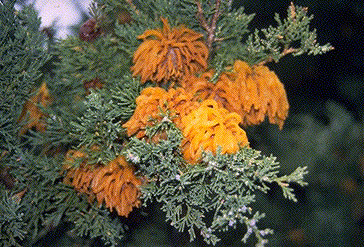
Cedar-Apple Rust Galls on Juniper
Have you notice cedar trees with orange globs? It looks like the trees have starting growing orange jelly. There is fungus among us. Find out what you can do now that infection has happened and if there is anything you can do to prevent it in the future.
This year has been a really ‘good’ year for fungus. The prolonged, wet spring we experienced last year allowed for all sorts of infections to happen this year. Cedars and junipers are just now showing the effects of rust fungi.
Cedar-apple rust, cedar-hawthorn rust, and cedar-pear rust are all caused by very interesting fungi. They require 2 hosts in order to complete their life cycle, a plant in the Juniper family and another plant in the Rose family (apple, hawthorn, pear, crabapple, & quince). The spores produced on one plant infect the other, and vice versa. In the spring of the year the juniper produces orange gelatinous masses, called telial horns, on the tree. The telial horns are masses of spores in ‘bloom’ that are releasing spores that infect the plant in the Rose family. The spores are released when we have wet weather in May and June. When the spores land on a susceptible host, they begin to infect causing spots on the leaf. As these spots mature, they produce their own spores that then infect the juniper and the cycle continues.
When they aren’t producing spores, the galls on the junipers look very different. The galls begin their lives as corky, brownish-green colored masses on the twigs. The galls can range in size from 1/8” to over 2” in diameter. As they mature, the galls become more reddish-brown and the surface looks dimpled, like a golf ball. During wet weather, the gelatinous telial horns expand and begin to release spores. Once they are done producing spores, they remain attached to the tree for several years. The galls normally don’t cause much damage to the juniper tree unless the infestation is severe.
Most of the damage to the susceptible host is done to the member of the Rose family. Cedar-apple rust causes the most injury to the apple host. The symptoms on the upper side of the leaf appear as yellowish-orange spots. As the infection progresses, in the middle of these yellow spots a dark brown spot will begin to develop. When the leaf is flipped over, the spots will be rough and raised in appearance. Most of the time the rust on the leaf of the Rose family plant will look unsightly, but it doesn’t cause long-term harmful effects to the plant. The leaf surface is still able to photosynthesize for the plant. If the infection is severe, there is the possibility that the leaves could prematurely drop off of the tree. If the infection is on an eating apple, you might notice reduced fruit quality due to the premature leaf drop.
There are several control measures that can be considered to help alleviate the problem. Removing all of the junipers in the near vicinity of the susceptible plant is not a feasible option. You would need to remove all juniper trees and shrubs within a 2 mile radius on your plant, not an easy task. Galls can be removed from the juniper plants and is practical if only a few galls are on the plant. Chemical control on junipers is not recommended because the infection rarely causes damage to the host. Additionally, timing of those applications would be from July through September, which would mean repeated applications on a regular basis throughout those 3 month and would prove to be costly in both time and product.
Sprays are only recommended during certain times of the year. If you have susceptible apple, crabapple, hawthorn, or pear and you are in the perfect window to start your control. If it is an eating apple, make sure the product you select is labeled for use on fruit trees. Preventative fungicide sprays to the susceptible Rose family species during the time the orange telial horns are present on the juniper trees can help to decrease the severity or prevent the rust problem. If you decide to spray, you will need to religiously spray the tree starting now and every 7-10 days (or whatever is recommend by the label) during the rainy season. If it rains following an application, be prepared to reapply as the products don’t have much of a residual. When the telial horns are gone on the cedars, so is the risk for infection.
There is a silver lining. When installing a new plant, consider selecting a cultivar with some disease resistance. There are several newer cultivars of eating apples and crabapples that are cedar-apple rust resistant. Selecting resistant cultivars will remove the need for fungicide sprays.
Don’t let the orange goo get you down. Correct identification is the first step to understanding this unique fungus.
Elizabeth Killinger is the Horticulture Extension Educator with Nebraska Extension in Hall County. For more information contact Elizabeth at elizabeth.killinger@unl.edu, her blog at https://huskerhort.com/, or HuskerHort on Facebook and Twitter.
